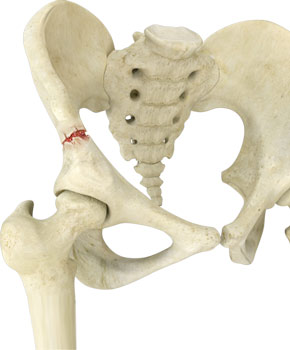
A pelvic fracture is a condition that arises due to the breakage of the pelvic bone. It may damage the internal organs, nerves and blood vessels associated with the pelvic region.
The pelvic bone is a circular arrangement of bones connected, with the help of strong ligaments, to the lowermost region of the spine called the sacrum. It is composed of three bones that are fused together, namely the ilium, ischium and pubis. The sides of the pelvis form cup-shaped sockets known as acetabulum.
Various organs related to the digestive and reproductive systems lie within the pelvic ring. Several large nerves and blood vessels supplying the lower limbs pass through the pelvis. The pelvis ring also acts as a point of attachment for muscles approaching from the upper and lower part of the body.
Based on the damage to the pelvic ring and associated structures, pelvic fractures can be categorised as:
- Stable pelvic fractures: Single point breakage in the pelvic ring and broken bones remain in position. Associated with less bleeding
- Unstable pelvic fractures: Breakage at two or more points. Associated with severe internal bleeding and damage to the internal organs. May cause shock, requiring immediate medical care followed by long-term physical therapy and rehabilitation
Causes
The common causes of pelvic fractures include:
- Sports injuries or trauma
- Abrupt muscle contraction
- Conditions such as osteoporosis, especially in the elderly
- Accidental injury or fall from a great height
Symptoms
The common symptoms associated with pelvic fractures are:
- Pain and swelling in the groin or hip region that may worsen with ambulation
- Abdominal pain
- Bleeding through the urethra or vagina and the rectum
- Problems in urination
- Inability to stand or walk
Diagnosis
Your doctor will diagnose pelvic fractures with a thorough physical examination that would include an examination of the functionality of the various organs present in the pelvic region. Imaging techniques such as X-rays, CT and MRI scans may also be ordered to confirm the fracture. In some cases, additional contrast studies with a radioactive dye may be recommended to evaluate the structural and functional activity of organs such as the urethra, bladder and the pelvic blood vessels.
Treatment
The treatment of a pelvic fracture depends upon the severity of the injury and your condition. Minor or stable fractures can be treated with conservative methods such as rest, medications, use of crutches, physical therapy and if required, minor surgery. These methods may take 8–12 months for complete healing.
The treatment of unstable fractures includes the management of bleeding and injuries to the internal organs, blood vessels and nerves. Surgical intervention may be employed for fixation of the fractured pelvic bones using screws and plates. Fixation provides stability to the pelvic bone and promotes natural healing of the fracture.
Related Topics
- Pelvis Fracture
- Acetabular Fracture
- Open Reduction Internal Fixation Of Humerus Fracture
- Femoral Neck Fractures
- Clavicle Fracture
- Scapula Fracture
- Mid Humeral Fracture
- Wrist Fracture
- Ankle Fractures
- Elbow Fracture
- Foot Fracture
- Syndesmosis Fixation With Tightrope Fixation
- Syndesmosis Without Tightrope
